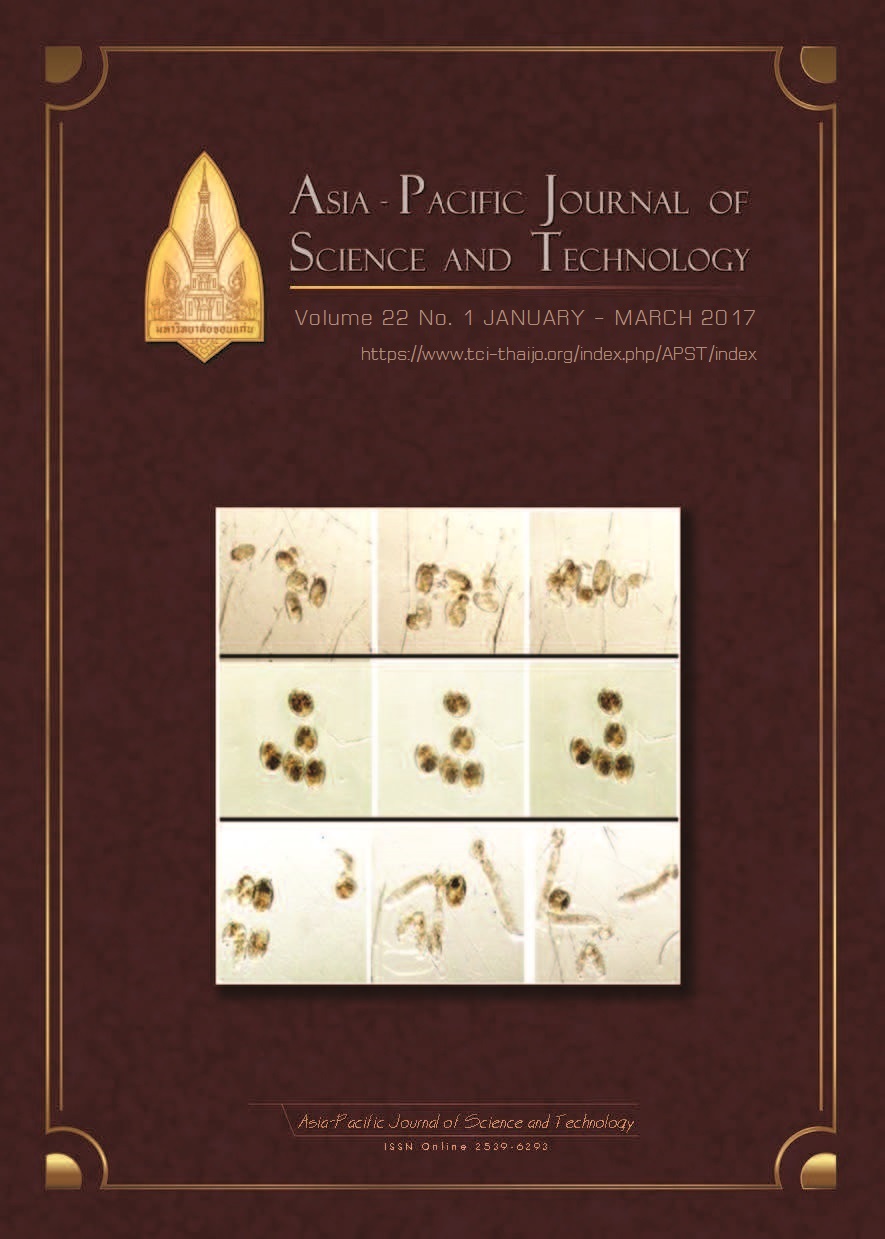Use of different materials as a carrier for plant growth promoting bacteria
Main Article Content
Abstract
Rhizobium and Azospirillum are rhizobacteria that enhance plant growth via nitrogen fixation, nutrient solubilization and hormone production. These activities make them beneficial as microbial bio-fertilizers for legumes and economic crops. In this study, solid-base inoculants, i.e., perlite, vermiculite and mixed media, were evaluated for their potential use as carriers for Rhizobium CIAT899 and Azospirillum VAs087. The chemical and physical properties of the carrier materials and the population of the two strains were determined. The results revealed that the various carriers showed different effects on growth and survival of CIAT899 and VAs087 during 120 days of incubation. Mixed media gave the highest number of both strains (108 to 109 CFU g-1 of carrier), while perlite and vermiculite supported survival at only 106-107 CFU g-1 of carrier during 10 to 30 days after inoculation. On average, the CIAT899 counts were higher in all the carriers than those of VAs087. The number of viable bacteria declined after reaching maximal numbers and remained stable at between 104 and 106 CFU g-1 of carrier after 90 days of incubation, depending on the type of carrier. The results indicated that the use of a mixed medium as a carrier was appropriate for the production of bacterial inoculants.
Article Details
References
[2] Somasegaran, P., Hoben, H.J., 1994. Handbook for Rhizobia: Methods in Legume Rhizobium Technology. Springer, Berlin Heidelberg New York, USA, 217–218.
[3] Sparrow, S.D. Jr., Ham, G.E., 1983. Survival of Rhizobium phaseoli in Six Carrier Materials. Agronomy Journal 75, 181-184.
[4] Sangeetha, D., Stella, D., 2012. Survival of Plant Growth Promoting Bacterial Inoculants in Different Carrier. International Journal of Pharmaceutical & Biological Archives 3, 170-178.
[5] Daza, A., SantamarõÂa, C., RodrõÂguez-Navarro, D.N., Camacho, M., Orive, R., Temprano, F., 2000. Perlite as a carrier for bacterial inoculants. Soil Biology and Biochemistry 32, 567-572
[6] Harben, P.W., Kuzvart, Milos., 1996. Vermiculite, in Global geology: London, United Kingdom, Industrial Minerals Information Ltd., 432-437.
[7] Alexandre-Franco, M., Albarran-Liso, A., Gomez-Serrano, V., 2011. An identification study of vermiculites and micas: Adsorption of metal ions in aqueous solution. Fuel Processing Technology 92, 200-205.
[8] Chaiwon, F., Santasup, C., Sringarm, K., Shutsrirung, A., 2013. Antioxidant Activity, Vitamin C Content and Growth of Chinese Kale in Response to High Humus Seedling Media and Beneficial Microorgnisms. Chiang Mai University Journal of Natural Sciences 12, 79-89.
[9] Atlas, R.M., 1996. Handbook of microbiological media., 2nd. Edited by L.C. Parks. CRC Press, Boca Raton, Fla.
[10] Shutsrirung, A., 2012. Selection of Beneficial Microorganisms in Highland Soils for Improvement of Acid and High Arsenic Soils. 2012. Final Report. High Land Research and Development Institution (Public Organization). Chiang Mai.
[11] Shutsrirung, A., 2013. Study and Development of Bio-product Prototype for Reducing Soil Acidity and Arsenic Toxicity in Highland Soils. 2013. Final Report. High Land Research and Development Institution (Public Organization). Chiang Mai.
[12] Iswara, V., 1969. Growth and survival of R. trifoli in coir dust and soybean meal compost. The Madras Agricultural Journal. 59, 52.
[13] Sivasakthivelan, P., Saranraj, P., 2013. Azospirillum and its Formulations: A Review. International Journal of Microbiology Research 4, 275-287.
[14] Arora, N.K., Tiwari, S., Singh, R., 2014. Comparative Study of Different Carriers Inoculated with Nodule Forming and Free-Living Plant Growth Promoting Bacteria Suitable for Sustainable Agriculture. Journal of Plant Pathology and Microbiology 5,2.
[15] Phiromtan, M., Thongchai, M., Srinives, P.,2013. Effect of Various Carriers and Storage Temperatures on Survival of Azotobacter vinelandii NDD-CK-1 in Powder Inoculant. Modern Applied Science 7, 81-89.


